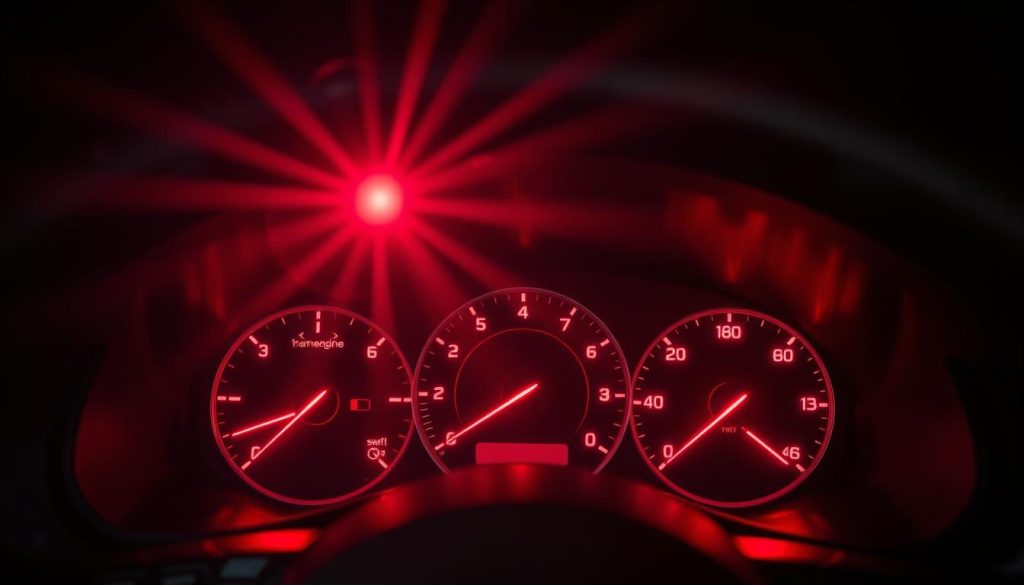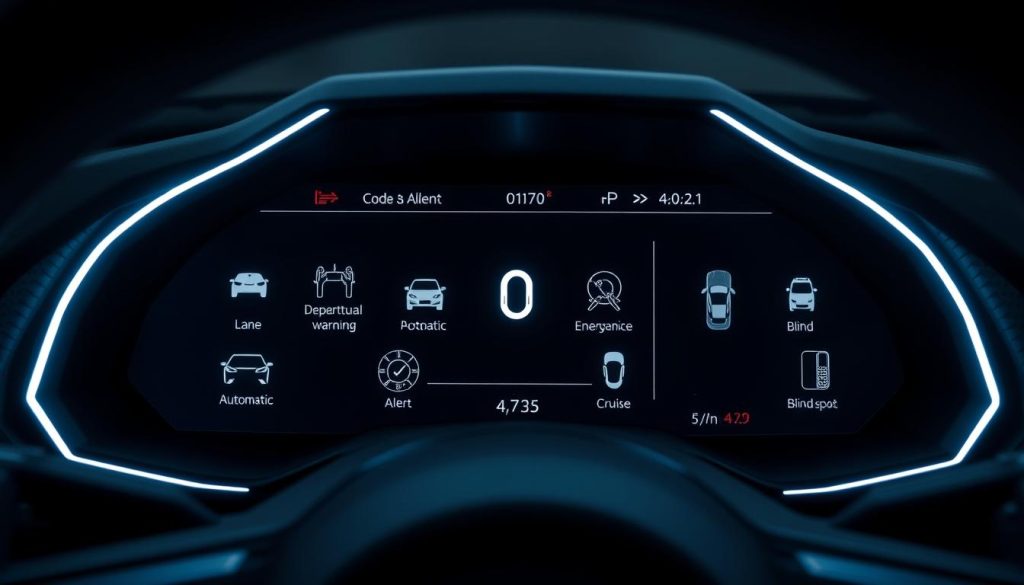Ever glance at your car’s instrument panel and wonder what those glowing symbols mean? You’re not alone. Modern vehicles use color-coded alerts to share vital information, acting like a silent co-pilot. Whether it’s a quick reminder or an urgent message, these signals are your ride’s way of saying, “Hey, let’s talk!”
Think of these icons as your vehicle’s personal language. A yellow symbol might mean “Check this soon,” while red often screams “Pull over now!” For example, that little oil can icon isn’t just decoration—it could prevent catastrophic engine damage if addressed quickly. Even the seatbelt reminder, though familiar, plays a key role in safety.
At Heaven Automotive, we believe knowledge is power. Understanding these alerts helps you avoid costly repairs and keeps you safe on highways or backroads. Don’t panic—most warnings simply mean your car needs routine care or a professional eye. That’s where our team steps in, ready to decode every blink and beep.
Key Takeaways
- Color-coded symbols act as your vehicle’s communication tool
- Yellow indicators suggest caution, while red signals demand immediate action
- Timely responses to alerts can prevent major mechanical issues
- Basic understanding reduces stress and promotes safer driving habits
- Professional diagnostics ensure accurate solutions for every warning
Dashboard Warning Lights Decoded: A Comprehensive Overview
Those tiny dashboard symbols hold the key to your car’s health. Modern vehicles use color-coded communication paired with universal icons to keep drivers informed. These alerts tap into your ride’s central nervous system—a network of sensors tracking everything from tire pressure to emissions.
Automakers design these signals to work like traffic lights. Amber glows suggest scheduled check-ups, like oil changes. Red flashes mean stop driving and seek help. Even basic reminders—like a door left ajar—connect to your car’s real-time monitoring network.
Today’s systems evolved from simple bulb indicators to smart messengers. They sync with onboard diagnostics (OBD) that scan 50+ components. This tech spots issues early, often before you notice changes in performance. For example, a blinking engine icon could flag a loose gas cap or deeper mechanical trouble.
Standardized symbols bridge language gaps across brands. A thermometer means engine overheating whether you drive a sedan or SUV. At Heaven Automotive, we translate these alerts into actionable fixes. Catching minor problems early saves hundreds in repairs—and keeps your travels worry-free.
The Critical Role of Dashboard Warning Lights in Vehicle Safety
Your car’s glowing icons are more than just pretty lights—they’re lifesaving messengers. These alerts act as your safety partners, working with sensors to catch issues before they spiral. Red signals mean “act now,” while amber ones whisper “schedule a checkup soon.”
Modern systems connect to vital components like brakes, steering, and engine controls. When something’s off, your ride sends instant notifications. A flickering symbol could mean low tire pressure reducing traction or engine trouble risking breakdowns. Responding quickly keeps you—and others—safe on busy roads.
Ignoring these alerts is like silencing a smoke alarm. What starts as a minor hiccup can snowball into dangerous mechanical failures. For example, delaying brake inspections might lead to longer stopping distances. At Heaven Automotive, we decode these signals efficiently, turning worries into solutions.
Trust matters when your safety’s on the line. Our experts use factory-grade tools to pinpoint issues, ensuring your vehicle stays reliable. Don’t ignore the glow—let’s keep your journeys smooth and secure together.
Recognizing Red Alert Dashboard Indicators
Ever feel your heart race when a red icon lights up your dash? These crimson signals mean stop driving now—not later. At Heaven Automotive, we’ve seen how quick responses to these alerts prevent blown engines and failed brakes.

Engine Oil Pressure & Brake System Warnings
Spot a red oil can symbol? Your engine oil pressure is critically low. Driving even two miles without proper lubrication can grind metal parts together. This warning often means leaks, pump failures, or dangerously low oil levels.
Another showstopper: the red exclamation mark inside parentheses. This brake system alert signals failing hydraulics or worn pads. If your pedal feels spongy or sinks to the floor, pull over immediately. Your stopping power could vanish within minutes.
Immediate Actions to Protect Your Vehicle
When red lights flash:
- Signal and coast to the road’s shoulder
- Turn off the engine to prevent further damage
- Check oil levels or brake fluid if safe
- Call for professional assistance
Other red alerts like battery or overheating symbols demand the same urgency. These systems give you just enough time to react—not enough to reach home. Our technicians use factory-grade scanners to diagnose issues accurately, whether it’s a faulty sensor or genuine mechanical trouble.
Remember: red means right now. We’ll help you navigate these high-stress moments with expertise honed from thousands of emergency repairs.
Understanding Amber Alert Lights and Cautionary Signals
Noticed a golden glow on your instrument cluster? Amber symbols act as your car’s early-warning system, suggesting attention needed within days—not minutes. These alerts often relate to emissions, traction control, or maintenance reminders that keep your ride running smoothly.
Insights on the Check Engine Light
That little orange engine icon—formally called the check engine light—might mean anything from a loose fuel cap to sensor issues. While it doesn’t demand immediate stops, ignoring it could lead to catalytic converter damage or reduced fuel efficiency. We use advanced scanners to pinpoint exact trouble codes, whether it’s a faulty oxygen sensor or misfiring cylinder.
ABS and Tire Pressure Monitor Signals
The horseshoe-shaped tire pressure light flashes when air levels drop 25% below recommendations. Underinflated tires wear unevenly and reduce gas mileage. Meanwhile, the ABS alert (an amber circle with “ABS”) means your anti-lock brakes need service—though standard braking still works. Both issues worsen if delayed, leading to costly repairs.
Here’s our golden rule for amber alerts:
- Schedule diagnostics within 48 hours
- Check tire pressures monthly
- Never reset warnings without fixing root causes
At Heaven Automotive, we transform these cautionary glows into actionable solutions. Catching minor issues early saves money and keeps your travels predictable. Let’s decode those amber whispers together—before they become shouts.
Green Informational Lights: What They’re Telling You
While red and amber lights get most attention, green indicators play an equally important role. These friendly symbols confirm your vehicle systems are working properly. They’re your car’s way of saying everything is operating as intended.
The headlight indicator is one common green light you’ll see. It simply lets you know your headlights are active. This confirmation is especially helpful during dusk or dawn driving.
Turn signal indicators provide another important green confirmation. When you activate your directional signals, the corresponding green arrow flashes. This confirms your turn signals are working and visible to other drivers.
Cruise control indicators appear in green when the system is active. This tells you your vehicle is maintaining your set speed. It’s a helpful confirmation that this convenience feature is engaged.
Many modern safety systems also use green lights. Lane departure warning and forward collision alert may show green when actively monitoring. These indicators help you understand which safety features are currently protecting you.
At Heaven Automotive, we believe understanding all your vehicle’s lights creates confident driving. While green symbols are generally positive, knowing what each one means maintains your awareness. This knowledge helps you stay in complete control of your car’s capabilities.
Advanced Driver Assistance Features and Their Indicators
Today’s vehicles are getting smarter, and their advanced driver assistance features communicate through a sophisticated language of colored indicators. These systems use subtle color changes to tell you exactly what’s happening with your car’s safety technology.

Lane Keep Assist and Adaptive Cruise Control
Lane Keep Assist uses a simple color code: white means the system is available but inactive. When it turns green, the feature is actively helping you stay centered in your lane. An amber flash signals when you’re drifting without using your turn signal.
Adaptive Cruise Control works similarly. A white indicator shows the system is ready but not set. Green means it’s actively maintaining your following distance from the vehicle ahead. This smart system adjusts your speed automatically for safer highway driving.
Understanding Super Cruise and Related Alerts
Super Cruise takes assistance to the next level with a light bar on your steering wheel. Solid green means the system is actively steering your vehicle. Blue indicates you’ve taken manual control temporarily.
The most critical signal is flashing red, which requires immediate driver intervention. Forward Collision Alert complements these systems by changing from green (vehicle detected) to amber (potential collision warning).
At Heaven Automotive, we help drivers master these advanced features. Understanding these indicators maximizes your safety benefits and keeps you in control of your vehicle’s smart capabilities.
Troubleshooting Dashboard Warning Lights
When an unfamiliar symbol illuminates your instrument cluster, having a troubleshooting plan brings peace of mind. We guide drivers through a systematic approach that starts with simple checks before considering professional service.
DIY Checks vs. Professional Diagnostics
Some alerts respond well to basic inspections. If your check engine light comes on, verify your gas cap is tight. For tire pressure warnings, check each tire’s air levels. These quick fixes often resolve the immediate problem.
However, most issues require deeper investigation. Modern vehicles store detailed computer codes that only specialized equipment can read. What appears as a simple warning might indicate a complex mechanical issue.
Never ignore symbols that turn off by themselves. Intermittent warnings often signal developing problems that need attention. Our technicians use factory-grade scanners to access system data unavailable to most drivers.
Knowing when to attempt basic checks versus when to call a mechanic protects your vehicle from additional damage. We provide accurate diagnostics that get to the root of every alert, ensuring your car receives the proper service it deserves.
Preventative Maintenance: Keeping Your Vehicle in Top Shape
What if you could prevent most vehicle alerts before they ever appear? Regular maintenance is your best defense against unexpected problems. At Heaven Automotive, we believe proactive care keeps your car running smoothly and safely.
Regular oil changes are crucial for engine health. Fresh oil prevents the pressure alert from activating. This simple service protects your engine from costly damage. Our technicians check fluid levels during every visit.
Brake system maintenance is equally important. We inspect pads and check brake fluid regularly. This prevents emergency stops and ensures your safety. Proper care keeps your braking system responsive.
Tire maintenance prevents pressure monitoring alerts. Regular rotations extend tire life. Coolant system checks avoid overheating problems. These services work together to protect your vehicle.
Investing in preventative maintenance saves money long-term. Small issues become major problems without proper care. Our comprehensive service packages address all critical systems. Let us help you avoid stressful driving moments.
Interpreting System Messages from Onboard Diagnostics
Your car’s computer system is constantly communicating with you through detailed messages. Modern vehicles use sophisticated onboard diagnostics that monitor hundreds of sensors throughout your vehicle.
Understanding Sensor Readings
These systems generate specific codes that pinpoint exact issues. A single alert might relate to engine performance, emissions, or safety features.
Our technicians use advanced scanners to read these sensor readings accurately. We translate complex data into understandable solutions for your car.
When to Consult the Owner’s Manual
Your owner’s manual provides valuable context for system messages. It explains what each warning light means and suggests initial steps.
For complex issues, professional diagnosis ensures proper resolution. We combine manual guidance with our expertise for complete vehicle care.
Understanding these messages helps you make informed decisions about your car’s needs. Let us help you decode your vehicle’s language with confidence.

